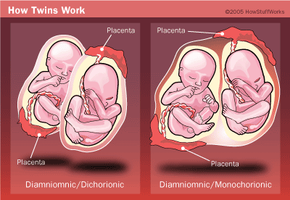It's Like Looking in a Mirror
Monozygotic (MZ) twins are often referred to as "identical twins." MZ twins happen in the same way a single birth happens — one sperm fertilizes one egg. However, shortly after fertilization, instead of the blastocyst remaining as one cell group, it splits in two. Exactly when this split happens actually determines how the twins will implant in the uterine lining. The earlier the split, the more independent the embryos will be. For example, if the split occurs very early — say sometime during day two — then the embryos will have separate chorions, amnions and placentas. This scenario represents approximately one-third of identical twins. (Although, like with DZ twins, the placentas could become fused.) Other possible scenarios are:
- The twins have separate amnions and separate placentas but share one chorion.
- The twins have separate amnions but share one chorion and one fused placenta.
- The twins share one chorion, one amnion and one placenta (rarest combination).
The placenta provides the developing baby with the nourishment and oxygen it requires. Therefore, it's preferable for the MZ twins to have separate placentas (even if they are fused). In some instances, MZ twins who share a placenta will not develop equally because one twin actually receives more nourishment via the placenta than the other twin does. This is known as fetal growth restriction. MZ twins who share a placenta are also at risk for a serious and potentially fatal condition known as Twin-to-Twin Transfusion Syndrome (TTTS).
Advertisement
In addition to the shared placenta, twins suffering from TTTS also share some circulation, thereby enabling the transfusion of blood from one twin to the other. The donor twin can become anemic and will be unusually small for his gestational age. Meanwhile the recipient twin will have an over abundance of blood supply and will be unusually large for his gestational age. Additionally, the donor has a dangerously low amount of amniotic fluid, while the recipient twin has too much. This abundance of fluid can cause the mother continuous discomfort, difficulty sleeping and pain. It is possible to treat some cases of TTTS using amniocentesis to remove the excess fluid or laser surgery to close the circulation connection between the twins. For more information regarding TTTS, visit the Twin-to-Twin Transfusion Syndrome Foundation.
Because MZ twins come from the same fertilized egg, they share identical genetic material. MZ twins can only be same-sex, meaning that there are two possible combinations:
- Two males
- Two females
If splitting occurs very late and is incomplete, conjoined twins result. Let's take a closer look at this type of twin.
